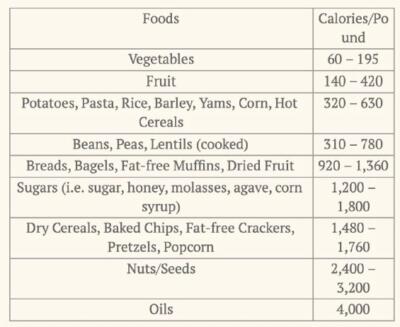#320 Is Caloric Density the Secret to Eating as Much as You Want without Gaining Weight?
 Dr. John Day
Dr. John DayDr. Day is a cardiologist specializing in heart rhythm abnormalities at St. Mark’s Hospital in Salt Lake City, Utah. He graduated from Johns Hopkins Medical School and completed his residency and fellowships in cardiology and cardiac electrophysiology at Stanford University. He is the former president of the Heart Rhythm Society and the Utah chapter of the American College of Cardiology. |

Podcast: Play in new window | Download
Subscribe: RSS
Is Caloric Density the Secret to Eating as Much as You Want without Gaining Weight?
By Kate Clemens with John Day
Is there a way to never feel hungry again and not gain weight? One answer is to mostly eat only those foods with the absolute lowest caloric density. In other words, a low caloric density means you want the most food you can get on your plate with the least amount of calories. And in this article, we’ll teach you everything you need to know about the low caloric density eating approach.
Dr. Day’s Experience with Low Caloric Density Eating
Focussing primarily on foods with the lowest caloric density has been something Dr. Day has done for the last 10 years to maintain his 30-pound weight loss. For him, pilling up his plate high with food not only fills his belly but also psychologically convinces his brain that he is full.
As vegetables have the lowest caloric density this is what fills up most of his plate. And because oils have the highest caloric density, he avoids them whenever possible. For example, when making a salad he puts berries, beans, nuts, and seeds on his salad, rather than salad dressing, because berries, beans, nuts, and seeds have a much lower caloric density (see chart).
In general, Dr. Day keeps his caloric density below 780 calories per pound unless he is eating nuts, seeds, or some very dark chocolate (>70% cacao and usually stevia-sweetened). Of note, his wild salmon measures in at about 780 calories per pound. On rare occasions, he will just put a small taste of salad dressing on a fork (he never puts the dressing on the salad) if berries, beans, nuts, or seeds are not available to flavor his salad.
Caloric Density Works
Caloric density is a straightforward approach to weight management that works. The idea is to increase the amount of food on your plate while decreasing your total caloric intake. You do this by paying attention to the calories per pound in the food you choose to eat. The best part of it is that you eat for satiety and optimize the amount of nutrients you take in at each meal.
5 Key Findings from Weight Loss and Caloric Density Research
What does research tell us about the caloric density eating approach? Below is a summary of the best studies:
1. People can eat freely foods that are about 300 calories per pound or less and not gain weight.
2. People can consume relatively large portions of foods that are between 400 and 800 calories per pound and still lose or maintain their weight depending on their individual activity levels and metabolism.
3. Foods with a calorie density of 800-1,800 should be limited as these can contribute to weight gain and interfere with efforts to lose weight.
4. Foods over 1,800 calories per pound should be extremely limited as these foods can very easily contribute to weight gain and obesity and can also greatly interfere with efforts to lose weight.
5. In 2007, the American Cancer Institute and the World Cancer Research Fund published a report which recommended the average calorie density of the American diet be lowered to 567 calories per pound. This can easily be achieved if one eats freely of unrefined, unprocessed fruits, veggies, starchy veggies, and intact whole grains and legumes. It is important to note that this means without the addition of salt, sugar and/or fat/oil to them.
Never Diet Again by Following the Caloric Density Eating Approach
Using the caloric density approach is one that is truly simple and based on common sense. Better yet, it is easy to stick with which allows you to manage your weight for the rest of your life without dieting. Because you essentially end up eating more food with fewer calories, you will feel satiated and happy.
In a nutshell, by having a rough idea of how many calories there are in a given weight of food, one can enjoy a larger amount of food without increasing their total daily caloric intake. Foods that fall in this category tend to be whole, natural foods that leave us satiated for longer. Also, while low in caloric density, they are high in nutrient density. So it’s a win-win.
Kate’s 6 Tips to Healthy Eating
1. Get in tune with hunger and satiety:
Eat only when you are hungry, and avoid eating past the point of satiety. Remember to eat slowly and chew your food well.
2. Order matters:
Start all meals with foods that are lower on the calorie density scale. This will help increase satiety and ensure you are eating nutrient-dense foods that will optimize your health.
3. Form matters:
Solid foods fill you up more than liquids of equal calories. Be mindful of your beverage choices and avoid any drinks with added sugars.
4. Dilution Solution:
Minimize the caloric density of your meals and increase the nutrient density with the 50/50 visual. Half of your plate by visual volume should be filled with non-starchy veggies.
5. Facts on Fats:
We need healthy fats to survive. No need to completely eliminate fats. However, keep in mind that even small amounts of healthy fats will greatly increase the caloric density of your meals. Be mindful of serving size when you are using avocados and olive oil, etc.
6. Less High Dense:
When you incorporate high calorically dense foods into your meals make sure the meal is already made up mainly of low calorically dense foods. The real goal is to keep your average caloric density as low as possible.
Also, if you liked the photo attached to this article, it is a picture I took this week on a night run in the mountains with my daughter overlooking the Salt Lake City valley.
Disclaimer Policy: This website is intended to give general information and does not provide medical advice. This website does not create a doctor-patient relationship between you and Dr. John Day. If you have a medical problem, immediately contact your healthcare provider. Information on this website is not intended to diagnose or treat any condition. Dr. John Day is not responsible for any losses, damages or claims that may result from your medical decisions.


Great article again! Thanks for offering simple suggestions for healthy eating.